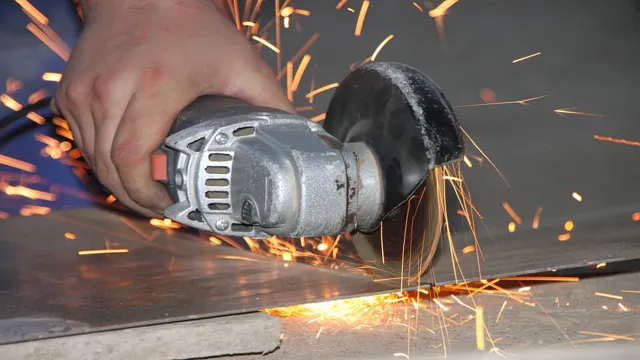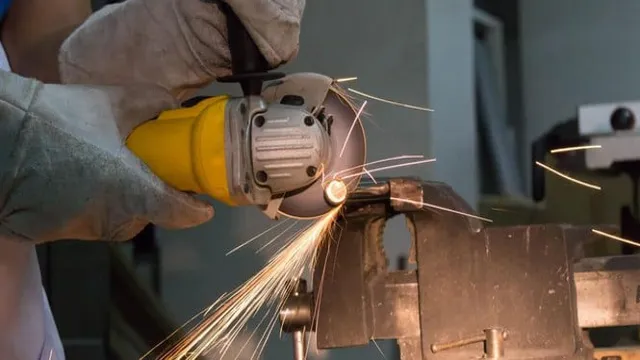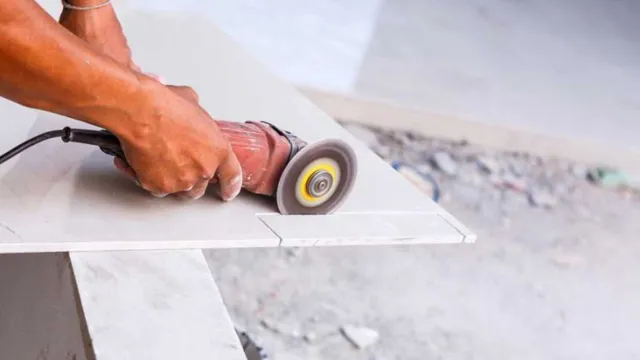How to Cut Metal with Angle Grinder: Tips and Tricks for Precision Cuts

If you’re looking for a versatile tool to cut metal, an angle grinder is your best bet. Angle grinders come equipped with abrasive discs that rotate at high speeds to cut through various materials with ease. Whether you’re a professional metalworker or a DIY enthusiast, using an angle grinder to cut metal is a straightforward process.
However, it’s important to use the right techniques and safety precautions to avoid injury or damaging the material. In this blog post, I’ll share some tips on how to cut metal with an angle grinder, so you can achieve precise cuts and create your desired project.
Safety Precautions
Cutting metal with an angle grinder should be taken seriously and requires safety precautions for the operator. First, it is recommended to wear proper personal protective equipment (PPE), including safety glasses, earplugs, gloves, and a face shield to protect against flying debris. It is also essential to secure the workpiece on a stable surface to prevent it from moving during cutting.
Keeping a firm grip on the angle grinder with both hands and not overusing pressure is important in reducing the risk of injury. Moreover, reducing the speed and changing the direction of the angle grinder during the cutting process will also minimize the chances of kickback. Lastly, turning off and unplugging the angle grinder before changing the disc is critical to avoid any unintentional start-up.
Following these safety measures when cutting metal with an angle grinder will enable a safer and more efficient experience.
Wear protective gear, like gloves and goggles.
If you work in an industry that involves handling hazardous chemicals or materials, or even if you just enjoy DIY projects at home, it’s essential to take the necessary safety precautions. Wearing protective gear, like gloves and goggles, can go a long way in preventing injury and keeping you safe. Chemicals and materials can cause serious harm if they come into contact with your skin or eyes, so make sure to protect yourself by wearing gloves and goggles.
While it might seem like an inconvenience to put on protective gear, it’s a small price to pay for your safety. You wouldn’t want to suffer an injury or harm yourself, and by taking this simple step, you can avoid a lot of potential hazards. Remember, safety should always come first, and wearing protective gear is a simple but effective way to stay safe.

Ensure the angle grinder is switched off and unplugged before attaching the metal cutting wheel.
When using an angle grinder to cut metal, safety should always be a top priority. One important safety tip to keep in mind is to ensure the angle grinder is switched off and unplugged before attaching the metal cutting wheel. This may seem obvious, but it is easy to forget in the midst of a project.
Taking this extra step can prevent accidents and injuries. Before beginning any work, it is also crucial to check that the wheel is compatible with the grinder and in good condition. Wearing protective gear, such as eye and ear protection, is also recommended.
Remember, taking the time to prioritize safety in metal cutting with an angle grinder can ultimately save time, money, and potentially even lives. So, always make sure to double-check before starting any project, and put safety first.
Secure the metal to a stable surface using clamps.
When securing metal to a stable surface using clamps, it’s essential to take several safety precautions to ensure that the process goes smoothly and safely. Always wear appropriate personal protective equipment like gloves and safety glasses before handling metal and clamps. Before securing, make sure that the metal is clean and free from any debris that may cause it to shift or slip under the clamps’ pressure.
Use the clamps appropriately, and never exceed their weight tolerance limits; doing so can cause them to bend or break, leading to serious injuries. Make sure that the clamps are securely tightened and do not move during the process. When working with larger pieces of metal, make sure you have the necessary assistance to handle them safely during the process.
Following these safety tips will make your metalworking experience safer and much more enjoyable.
Choosing the Right Wheel
When it comes to cutting metal with an angle grinder, choosing the right wheel is crucial for getting the job done quickly and efficiently. There are different types of wheels available, each designed for specific tasks such as cutting through thick metal or smoothing out rough edges. The most common type of wheel used for metal cutting is the abrasive wheel, which is made of a mixture of abrasive particles and a bonding agent.
This type of wheel is perfect for cutting through tough materials and can be used on a variety of metals. However, it’s important to choose the appropriate abrasive wheel for the specific type of metal you’re cutting to avoid damaging the wheel or the material. Whether you’re working on a small DIY project or a professional job, taking the time to choose the right wheel can make a big difference in the outcome of your project.
So, make sure to invest in the right type of wheel and take the proper safety precautions when working with an angle grinder.
Select a metal cutting wheel suitable for your angle grinder.
When it comes to selecting a metal cutting wheel for your angle grinder, there are a few key things to consider. First and foremost, you want to choose a wheel that is suitable for the type of metal you will be cutting. Some wheels are better for softer metals like aluminum, while others are designed for harder metals like steel.
Another important factor to keep in mind is the size of the wheel. You’ll need to choose a wheel that is the right diameter for your angle grinder, and that is compatible with the arbor size. Additionally, you’ll want to consider the thickness of the wheel.
Thinner wheels are great for making precise cuts, while thicker wheels are better for heavy-duty cutting tasks. Remember, choosing the right wheel is essential for getting the job done safely and effectively. So take the time to select the right wheel for the job, and don’t be afraid to ask for advice or recommendations from a professional if you’re unsure.
Ensure the wheel has the correct diameter for your grinder.
Choosing the right wheel for your grinder is essential for optimal performance and safety. One crucial factor to consider is the diameter of the wheel. The diameter of the wheel must match the size of your grinder.
A wheel that does not have the correct diameter may wobble, causing uneven grinding, damage to the wheel, and potentially dangerous situations. To determine the correct diameter for your wheel, check the manual that came with your grinder. If you no longer have the manual, measure the distance between the two spindle nut flats on your grinder with a ruler or tape measure.
Once you have this measurement, choose a wheel that matches the diameter. Don’t forget to regularly inspect and replace your wheels as needed to ensure safe and effective grinding. By choosing the right size and maintaining your wheels, you’ll be able to get the most out of your grinder while keeping safety a top priority.
Purchase a wheel specifically designed for the type of metal you plan to cut.
When it comes to cutting metal, choosing the right wheel is crucial for a successful outcome. You want to make sure you purchase a wheel specifically designed for the type of metal you plan to cut. Using the wrong wheel can not only result in a poor cut, but it could also be dangerous.
For example, if you try to cut stainless steel with a wheel designed for aluminum, the wheel will wear out quickly, and you may experience kickback, which could lead to injury or damage to your equipment. To avoid these risks, make sure you research and purchase the correct wheel for your project. By doing this, you’ll ensure a precise cut and a safe work environment.
Cutting Techniques
If you’re looking to cut metal with an angle grinder, there are a few techniques to keep in mind. First, make sure that you have the right type of blade for the job. A diamond blade is ideal for cutting through metal, but they can be expensive.
A more affordable option is a metal cutting wheel, which is also effective. Once you have your blade, make sure that it’s securely attached to your angle grinder. Next, take safety precautions by wearing goggles and gloves.
Hold the angle grinder with both hands and apply gentle pressure to the metal, making sure to keep the grinder moving in a straight line. You may need to make multiple passes to achieve a clean cut. Remember to take breaks and allow the grinder to cool down, as it can become quite hot with extended use.
With some practice and patience, cutting metal with an angle grinder can be a relatively simple process.
Position the angle grinder at a comfortable height and angle for cutting.
When it comes to using an angle grinder for cutting, the height and angle at which you position the tool play a crucial role in achieving a successful cut. First off, you’ll want to make sure the angle grinder is at a comfortable height for you to operate without straining your back or arms. This will enable you to maintain a steady hand and control the tool more effectively.
Additionally, finding the right angle for cutting is equally important. Depending on the type of project or material you’re cutting through, you may need to adjust the angle accordingly. By positioning the angle grinder at the appropriate height and angle, you’ll be able to achieve a precise cut with smooth edges that require minimal finishing.
Remember to prioritize safety by wearing the appropriate protective gear, such as goggles and gloves, while cutting. And as always, make sure to follow the manufacturer’s instructions and take necessary precautions when using the tool.
Hold the angle grinder at a 45-degree angle to the metal.
If you’re looking to cut metal using an angle grinder, following the right cutting technique is crucial for ensuring that you achieve the desired results. One of the most important things to keep in mind is that you should always hold the angle grinder at a 45-degree angle to the metal. This will help you to make smooth, clean cuts without damaging the blade or the metal.
It’s also important to use the right type of blade for the job, as this will affect the speed and accuracy of the cut. When you start cutting, make sure to keep your hands steady and to work slowly and carefully to avoid mistakes. With the right technique and some practice, you’ll soon be able to make precise cuts in metal that look professional and clean.
So, if you’re planning to cut some metal with your angle grinder anytime soon, remember to hold it at a 45-degree angle and take your time to ensure the best possible results.
Start the grinder and allow the wheel to reach full speed before making contact with the metal.
When it comes to cutting metal with a grinder, using the right technique is crucial to getting a clean and precise cut. One key factor to keep in mind is to always start the grinder and allow the wheel to reach full speed before making contact with the metal. This helps to ensure that the wheel is spinning at its full capacity and reduces the risk of it wobbling or jumping when it comes into contact with the metal, which can lead to an uneven cut and even pose a safety hazard.
Another important technique to keep in mind is to maintain a steady hand and apply even pressure when guiding the grinder along the metal. This helps to ensure that the cut remains straight and uniform, rather than wavering or veering off course. It’s also important to position the grinder at the correct angle, typically around 90 degrees, to ensure that the wheel cuts cleanly through the metal without overheating or getting bogged down.
Lastly, it’s important to take frequent breaks while cutting, both to rest your hands and to give the grinder time to cool down. This can prevent the wheel from becoming worn down too quickly, which can affect the quality of the cut and even damage the grinder itself. By using these cutting techniques and taking the necessary precautions, you can ensure a clean, precise cut every time you use your grinder.
Cut slowly and steadily, moving the grinder along the cutting line.
When it comes to cutting with a grinder, it’s essential to use the right cutting technique to ensure precision and safety. One of the most important things to remember is to cut slowly and steadily, moving the grinder along the cutting line. This will help you get clean, straight cuts without any jagged edges or uneven surfaces.
It’s also important to keep the grinder at a consistent angle and apply moderate pressure while cutting. This will help you control the speed and depth of the cut, preventing the blade from overheating or getting stuck. By using these cutting techniques, you can get the job done quickly and efficiently, while still achieving professional-level results.
So, the next time you’re cutting with a grinder, take your time, stay focused, and always keep safety in mind.
Apply light pressure, as too much pressure can damage the wheel.
When it comes to cutting techniques, it’s important to remember that using too much pressure can damage the wheel. That’s why it’s important to apply light pressure as you cut. It can be tempting to push harder to get the job done faster, but that can do more harm than good.
Instead, let the wheel do the work and use just enough pressure to guide it where you need it. Think of it like using a knife to cut vegetables – you wouldn’t use too much force or you might end up damaging the vegetables or injuring yourself. The same principle applies here.
By using gentle pressure, you can ensure that your cuts are precise and clean without risking any damage to the wheel. With a little bit of practice, you’ll be able to find the right balance and achieve professional-quality results every time.
Complete the cut, switch off the grinder, and remove the metal cutting wheel.
Cutting Techniques When using a metal cutting wheel on a grinder, it’s important to utilize proper cutting techniques to ensure a clean and accurate cut. Firstly, make sure that the metal you are cutting is securely clamped to prevent any dangerous movement. Next, carefully approach the cut and initiate the cut with a light touch to get through any initial resistance.
Once the cut has begun, continue to apply consistent pressure to the metal cutting wheel while moving the grinder along the marked cut line. Finally, complete the cut, switch off the grinder, and carefully remove the metal cutting wheel. By utilizing these cutting techniques, you can ensure a safe and accurate cut while using a grinder for your metalworking needs.
Remember to always prioritize safety and take your time to achieve the best outcome possible.
Conclusion
Cutting metal with an angle grinder requires a bit of skill, a bit of patience, and the right tools. Whether you’re a DIY enthusiast or a seasoned metalworker, you’ll need a good quality angle grinder, a steady hand, and plenty of cutting discs. With the right technique, you can create precise cuts and even intricate designs with ease.
So, if you’re looking to add some metalwork to your DIY projects or simply need to cut through metal quickly and efficiently, grab your angle grinder and get to work. Just don’t forget to wear safety glasses and ear protection – sparks are flying, and metal is loud!”
FAQs
What type of blade should I use to cut metal with an angle grinder?
For cutting metal with an angle grinder, a cutting wheel or a grinding wheel will work best. Make sure the wheel is suitable for metal cutting and not for wood or other materials.
How do I prepare the metal before cutting with an angle grinder?
Make sure the metal is securely clamped down before cutting, and remove any rust or debris from the area where you will be cutting. This will make it easier to make a clean cut.
What safety precautions should I take when cutting metal with an angle grinder?
Always wear appropriate eye and ear protection when operating an angle grinder. Additionally, wear gloves and a face shield to protect yourself from sparks. Never operate the tool with loose clothing or jewelry.
How fast should I operate the angle grinder when cutting metal?
The speed will depend on the type of metal you are cutting and the size of the cutting wheel you are using. Follow the manufacturer’s guidelines for speed and use a steady, even pressure.
Can an angle grinder cut through thick metal?
Yes, an angle grinder can cut through thick metal with the right blade and technique. However, for very thick metal, a specialized tool may be needed.
What is the best angle to hold the grinder when cutting metal?
Hold the grinder at a 90-degree angle to the metal surface for the most effective cutting. If you need to cut a curve, adjust the angle accordingly.
How do I prevent the angle grinder from overheating when cutting metal?
Use a high-quality, heat-resistant cutting wheel and avoid pushing the tool too hard, which can cause the motor to overheat. Take frequent breaks to allow the tool to cool down between cuts.



